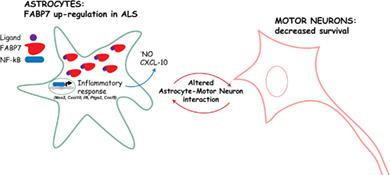Our official English website, www.x-mol.net, welcomes your
feedback! (Note: you will need to create a separate account there.)
FABP7 upregulation induces a neurotoxic phenotype in astrocytes.
Glia ( IF 5.4 ) Pub Date : 2020-07-03 , DOI: 10.1002/glia.23879 Kelby M Killoy 1 , Benjamin A Harlan 1 , Mariana Pehar 2 , Marcelo R Vargas 3
Glia ( IF 5.4 ) Pub Date : 2020-07-03 , DOI: 10.1002/glia.23879 Kelby M Killoy 1 , Benjamin A Harlan 1 , Mariana Pehar 2 , Marcelo R Vargas 3
Affiliation

|
Fatty acid binding proteins (FABPs) are key regulators of lipid metabolism, energy homeostasis, and inflammation. They participate in fatty acid metabolism by regulating their uptake, transport, and availability of ligands to nuclear receptors. In the adult brain, FABP7 is especially abundant in astrocytes that are rich in cytoplasmic granules originated from damaged mitochondria. Mitochondrial dysfunction and oxidative stress have been implicated in the neurodegenerative process observed in amyotrophic lateral sclerosis (ALS), either as a primary cause or as a secondary component of the pathogenic process. Here we investigated the expression of FABP7 in animal models of human superoxide dismutase 1 (hSOD1)‐linked ALS. In the spinal cord of symptomatic mutant hSOD1‐expressing mice, FABP7 is upregulated in gray matter astrocytes. Using a coculture model, we examined the effect of increased FABP7 expression in astrocyte‐motor neuron interaction. Our data show that FABP7 overexpression directly promotes an NF‐κB‐driven pro‐inflammatory response in nontransgenic astrocytes that ultimately is detrimental for motor neuron survival. Addition of trophic factors, capable of supporting motor neuron survival in pure cultures, did not prevent motor neuron loss in cocultures with FABP7 overexpressing astrocytes. In addition, astrocyte cultures obtained from symptomatic hSOD1‐expressing mice display upregulated FABP7 expression. Silencing endogenous FABP7 in these cultures decreases the expression of inflammatory markers and their toxicity toward cocultured motor neurons. Our results identify a key role of FABP7 in the regulation of the inflammatory response in astrocytes and identify FABP7 as a potential therapeutic target to prevent astrocyte‐mediated motor neuron toxicity in ALS.
中文翻译:

FABP7 上调在星形胶质细胞中诱导神经毒性表型。
脂肪酸结合蛋白 (FABP) 是脂质代谢、能量稳态和炎症的关键调节剂。它们通过调节核受体配体的摄取、运输和可用性来参与脂肪酸代谢。在成人大脑中,FABP7 在富含源自受损线粒体的细胞质颗粒的星形胶质细胞中尤为丰富。线粒体功能障碍和氧化应激与肌萎缩侧索硬化 (ALS) 中观察到的神经退行性过程有关,无论是作为主要原因还是作为致病过程的次要组成部分。在这里,我们研究了 FABP7 在人超氧化物歧化酶 1 (hSOD1) 相关的 ALS 动物模型中的表达。在有症状的 hSOD1 表达突变小鼠的脊髓中,FABP7 在灰质星形胶质细胞中上调。使用共培养模型,我们检查了 FABP7 表达增加对星形胶质细胞 - 运动神经元相互作用的影响。我们的数据表明,FABP7 过表达直接促进了非转基因星形胶质细胞中 NF-κB 驱动的促炎反应,最终不利于运动神经元的存活。添加能够在纯培养物中支持运动神经元存活的营养因子并不能防止与 FABP7 过表达星形胶质细胞共培养中的运动神经元丢失。此外,从有症状的 hSOD1 表达小鼠获得的星形胶质细胞培养物显示出 FABP7 表达上调。在这些培养物中沉默内源性 FABP7 会降低炎症标志物的表达及其对共培养运动神经元的毒性。
更新日期:2020-07-03
中文翻译:

FABP7 上调在星形胶质细胞中诱导神经毒性表型。
脂肪酸结合蛋白 (FABP) 是脂质代谢、能量稳态和炎症的关键调节剂。它们通过调节核受体配体的摄取、运输和可用性来参与脂肪酸代谢。在成人大脑中,FABP7 在富含源自受损线粒体的细胞质颗粒的星形胶质细胞中尤为丰富。线粒体功能障碍和氧化应激与肌萎缩侧索硬化 (ALS) 中观察到的神经退行性过程有关,无论是作为主要原因还是作为致病过程的次要组成部分。在这里,我们研究了 FABP7 在人超氧化物歧化酶 1 (hSOD1) 相关的 ALS 动物模型中的表达。在有症状的 hSOD1 表达突变小鼠的脊髓中,FABP7 在灰质星形胶质细胞中上调。使用共培养模型,我们检查了 FABP7 表达增加对星形胶质细胞 - 运动神经元相互作用的影响。我们的数据表明,FABP7 过表达直接促进了非转基因星形胶质细胞中 NF-κB 驱动的促炎反应,最终不利于运动神经元的存活。添加能够在纯培养物中支持运动神经元存活的营养因子并不能防止与 FABP7 过表达星形胶质细胞共培养中的运动神经元丢失。此外,从有症状的 hSOD1 表达小鼠获得的星形胶质细胞培养物显示出 FABP7 表达上调。在这些培养物中沉默内源性 FABP7 会降低炎症标志物的表达及其对共培养运动神经元的毒性。











































 京公网安备 11010802027423号
京公网安备 11010802027423号